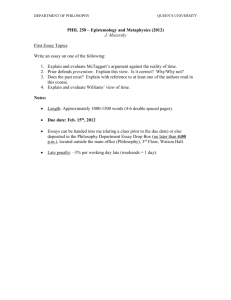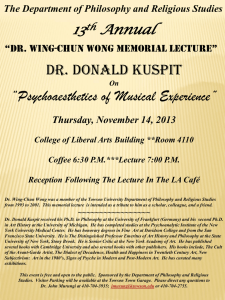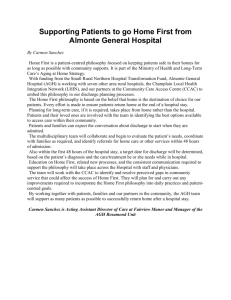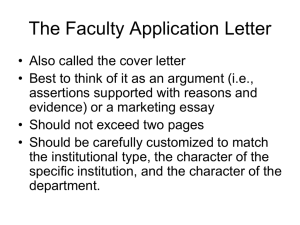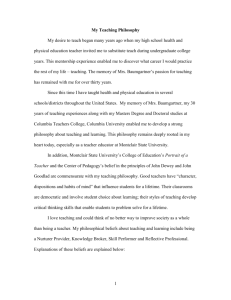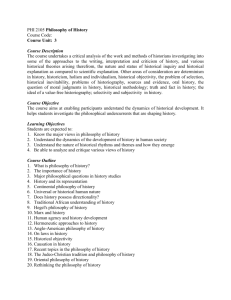Writing a Teaching Statement Transitioning to Professorship
advertisement
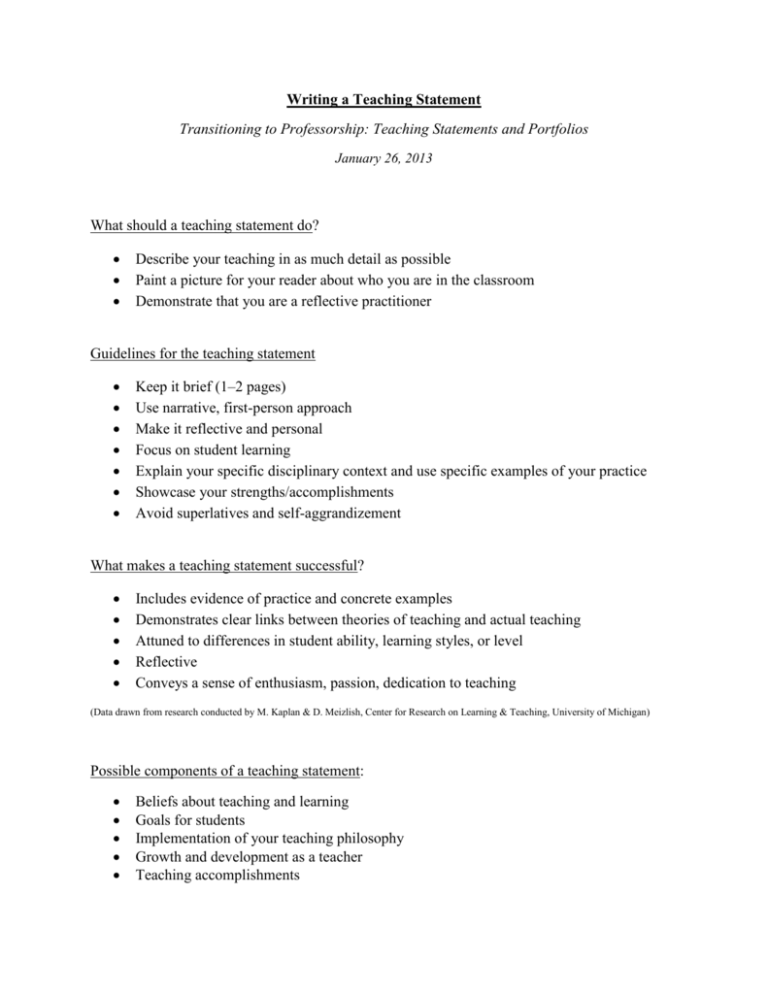
Writing a Teaching Statement Transitioning to Professorship: Teaching Statements and Portfolios January 26, 2013 What should a teaching statement do? Describe your teaching in as much detail as possible Paint a picture for your reader about who you are in the classroom Demonstrate that you are a reflective practitioner Guidelines for the teaching statement Keep it brief (1–2 pages) Use narrative, first-person approach Make it reflective and personal Focus on student learning Explain your specific disciplinary context and use specific examples of your practice Showcase your strengths/accomplishments Avoid superlatives and self-aggrandizement What makes a teaching statement successful? Includes evidence of practice and concrete examples Demonstrates clear links between theories of teaching and actual teaching Attuned to differences in student ability, learning styles, or level Reflective Conveys a sense of enthusiasm, passion, dedication to teaching (Data drawn from research conducted by M. Kaplan & D. Meizlish, Center for Research on Learning & Teaching, University of Michigan) Possible components of a teaching statement: Beliefs about teaching and learning Goals for students Implementation of your teaching philosophy Growth and development as a teacher Teaching accomplishments Prompts for writing and reflection: What is your most memorable classroom experience (positive or negative)? What teaching lesson is contained in that memory? In 1-2 sentences, characterize your classroom manner and approach to teaching. Finish this sentence: When I am teaching at my best, I am like a…. If you are stuck, think about the characteristics of bad teaching. What do you see as your primary teaching goals? What knowledge, skills, and attitudes do you see as important for success in your discipline? What value does your discipline have for non-majors? What, for you, constitutes evidence of student learning? How do you assess student learning? How do you get students intellectually engaged with your field? What kinds of questions do you ask? What kinds of problems do you pose? Write about one moment when you experienced a success in the classroom. Write about a moment when you were challenged by the task of teaching. How do you recognize and respect diversity in the classroom? How do you work to create an inclusive learning environment? What new techniques and activities have you experimented with in the classroom? What conceptions or misconceptions about your field do students bring to the classroom? How do you work to build on, unsettle, or correct those beliefs? How do you develop your students’ interpretive frameworks, or how do you teach them to approach the objects of analysis in your field? What questions do you teach them to ask, and how do you teach them how to answer them? How do you explain or otherwise help students understand difficult ideas or concepts (e.g., hydrogen bonding, false consciousness, etc.)? What particular offering does your discipline make to a student’s liberal arts education? How do you help students understand the implications or significance of what they’re learning or learning how to do in your classes? How do you balance your objectives for your students with your own? What are the most important lessons you have learned as a teacher? Additional Resources Vanderbilt Center for Teaching – Teaching Guide on Writing a Teaching Statement: http://cft.vanderbilt.edu/teaching-guides/reflecting/teaching-statements/ Duquesne University Center for Teaching Excellence – Guide to Writing a Statement of Teaching Philosophy (includes a variety of writing exercises): http://www.duq.edu/about/centers-and-institutes/center-for-teachingexcellence/academic-careers/landing-an-academic-job/statement-of-teaching-philosophy Ohio State University Center for the Advancement of Teaching – Guide to Writing a Philosophy of Teaching Statement (includes many different sample statements): http://ucat.osu.edu/teaching_portfolio/philosophy/philosophy2.html Goodyear, Gail & Allchin, Douglas. (1998). “Statement of teaching philosophy.” To Improve the Academy 17, 103-22. Stillwater, OK: New Forums Press. (Available in the Center for Teaching library.) Grundman, Helen. (2006). “Writing a teaching philosophy statement.” Notices of the American Mathematical Society, Vol. 53, No. 11, 1329-1333. (Available through the Vanderbilt CFT teaching guide.) Chism, Nancy. (1998). “Developing a philosophy of teaching statement.” Essays on Teaching Excellence 9 (3), 1-2. Professional and Organizational Development Network in Higher Education. Montell, Gabriela. (2003). “How to Write a Statement of Teaching Philosophy.” From The Chronicle of Higher Education, available online at: http://chronicle.com/article/How-to-Write-a-Statement-of/45133/ Austin, Rachel Narehood. (2006). “Writing the teaching statement.” From the “Career Advice” column of Science, available online at: http://sciencecareers.sciencemag.org/career_magazine/previous_issues/articles/2006_04_ 14/writing_the_teaching_statement



